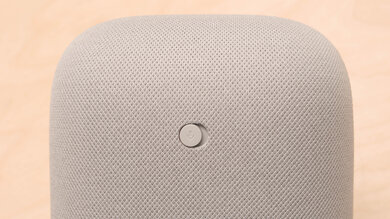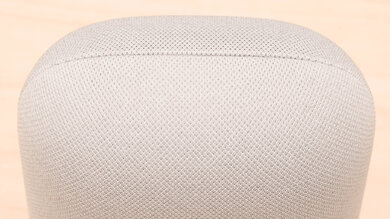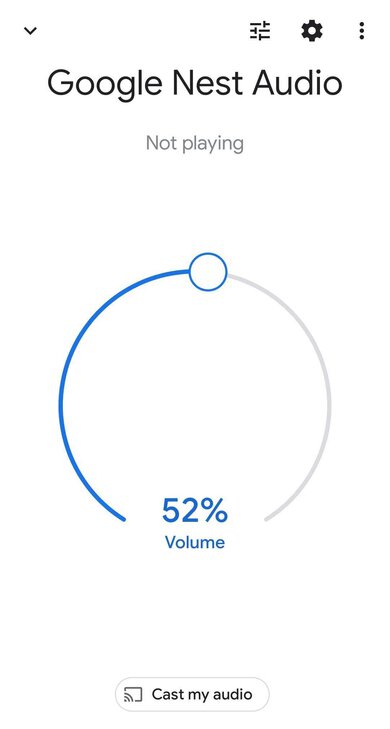The Google Nest Audio is a premium smart speaker that's larger than the Google Nest Mini. It has a sleek and stylish design that's available in a multitude of different colors to match your home decor, with a wired design so you can plug it right into an outlet for round-the-clock use. With built-in Google Assistant, it's designed for hands-free use, meaning you can control its features right from the comfort of your couch. You can even stream from other compatible devices over Google Chromecast, which is a nice touch.
Our Verdict
The Google Nest Audio is acceptable for music. Right out of the box, it has an even and balanced frequency response, especially in the mids. Voices and lead instruments are clearly and accurately reproduced, so it's suitable for a wide range of audio content. While audio sounds a bit dull due to a dip in the treble, you can customize its bass and treble output to suit your needs. It's loud enough to fill an average-sized room with sound, but unfortunately, it's not ideal for larger, more open spaces.
- Bass and treble adjustments.
- Some compression at max volume.
The Google Nest Audio is middling for videos and movies, though it isn't designed with this use in mind. It's Bluetooth and Wi-Fi compatible, so you can stream audio from your phone while you watch videos on your device. Unfortunately, there are latency issues, so the audio you hear can be out of sync with the video you see on screen. Some apps compensate for this differently, but lip-synching issues take away from the more immersive feel.
- Bass and treble adjustments.
- Some compression at max volume.
- High latency.
The Google Nest Audio is passable for podcasts. Thanks to its balanced frequency response, especially in the mids, dialogue is reproduced with accuracy and fidelity from the jump. While the dip in the treble adds a dull quality to the mix, you can always use its bass and treble adjustments to get a better sound. It's loud enough for most settings, but if you have a larger space, you may have trouble following along.
- Bass and treble adjustments.
- Bluetooth and Wi-Fi compatible.
- Some compression at max volume.
- Needs to be plugged into an AC outlet.
The Google Nest Audio is great for voice assistants. With built-in Google Assistant support, you can control it using only your voice. Whether you're on the couch or further away from the device, it doesn't have any trouble hearing your commands. It can have trouble understanding you in noisier environments like parties, though. You can also mute the microphone if you don't want the device to listen to you, which is a nice touch.
- Excellent far-field performance.
- Microphone mute feature.
- Some compression at max volume.
The Google Nest Audio isn't designed for outdoor use and needs to remain connected to a power outlet to work.
Changelog
- Updated Feb 28, 2023: Added a market comparison for the Apple HomePod (2nd generation) to the Frequency Response Accuracy box.
- Updated Jan 03, 2023: Updated the review text for accuracy and consistency. No changes to test results.
- Updated Dec 14, 2021: Updated review for accuracy and clarity.
- Updated Dec 18, 2020: Review published.
Check Price
Differences Between Sizes And Variants
This speaker comes in several different color variants, including 'Chalk', 'Charcoal', 'Sky', 'Sage', and 'Sand'. We tested the 'Chalk' variant, but we expect the others to perform similarly.
If you come across another version of this speaker, let us know in the discussions, and we'll update our review.
Popular Speaker Comparisons
The Google Nest Audio smart speaker has built-in Google Assistant capabilities. It has excellent far-field performance, and you can easily mute its microphone when you don't want the speaker to hear you. Unfortunately, it doesn't get very loud and isn't suitable for outdoor use. Like the Google Nest Mini and the discontinued Google Home Max, it's compatible with the incredible Google Home app, so you can adjust its bass and treble levels and pair it with other Google speakers.
See also our recommendations for the best smart speakers, the best home speakers, and the best Google speakers.
The Google Home Max and the Google Nest Audio are similar speakers, but the Home Max has a more versatile performance. The Home Max's sound profile is better-balanced, and it can get louder. Also, it has lower latency over a Wi-Fi connection, so it's a better choice for watching videos and supports multi-device pairing. That said, both speakers are great for voice assistant support.
The Google Nest Audio and the Google Nest Mini (2nd Gen) are very similar speakers with great voice assistant performances thanks to their built-in Google Assistant capabilities. However, the Nest Audio is better for music and watching videos. The Nest Audio has a more extended bass, and it can get louder. Also, it has lower latency over a Chromecast connection.
The Google Nest Audio and the Apple HomePod mini are very similar speakers overall. Your preference will come down to your preferred ecosystem. The Google comes with Google Assistant built-in, while the Apple comes with Siri support. In terms of sound, the Apple has a wider and more spacious-sounding soundstage.
Depending on your listening habits, you may prefer either the Google Nest Audio or the Apple HomePod (2nd generation). Both smart speakers offer great voice assistant support through their respective assistants, though Apple's Siri does a bit better in noisier environments. The Apple has a more extended low-bass, which is great for listening to bass-centric music. However, it doesn't come with bass and treble adjustments like the Google speaker, so you can't customize its sound.
Test Results

The Google Nest Audio has a fairly discreet and minimal design. It sits vertically on its base and has a unique, somewhat oval shape. It isn't very tall or wide, so it'll fit easily into most home decor. Four horizontal lights display when the speaker is active. You can get this speaker in several different colors, including Chalk, Charcoal, Sky, Sage, and Sand.
This speaker isn't very portable since it needs to remain wired to a power outlet for it to work. That said, since it's fairly small and lightweight, you can easily move it from one room to another in your home.
The speaker's mostly made of plastic, which feels solid and durable. It sits on a rubber-like base. The body is covered in a tight fabric, which feels very nice, though it could collect dust over time. Also, it isn't water-resistant, so be cautious if you plan to use it near water.
On the top of the speaker, there are touch-sensitive controls that let you adjust the volume, play/pause your music, and answer/end a call. That said, there aren't any markings or lights to let you know where they are, so you need to know where to tap the speaker. The horizontal lights on the front help display the volume level. There's a physical mic mute switch on the rear of the speaker, which you can use when you no longer want the voice assistant to listen to you.
The speaker's frequency response accuracy isn't bad. Out of the box, it has a pretty even sound, especially in the mids, where most voices and lead instruments are reproduced. As a result, it's suitable for listening to lots of different types of audio content. That said, the dip in the treble makes audio sound a bit dull, and it doesn't have as much low-bass as other smart speakers like the Apple HomePod (2nd generation). There are bass and treble adjustments in the app to customize its performance, though.
The soundstage is mediocre. It needs to be paired to another speaker to play stereo audio, and otherwise downmixes stereo content to mono when using it on its own, which doesn't sound as immersive. Fortunately, its directivity is very good, so its soundstage is perceived as more open and spacious. For a mono speaker with better directivity, check out the Apple HomePod mini.
The speaker gets loud enough to fill an average-sized living room with sound. That said, it isn't meant to fill larger or more open spaces, and as you turn up the volume, there's more compression in the mix.
Like the Google Nest Mini, this speaker comes with Google Assistant built-in, which you can activate with your voice. It does an excellent job of understanding your commands from far away, though it doesn't perform as well in noisier settings. There's a mute mic button you can use when you no longer want it to listen to you. If you're looking for a speaker that can understand you better in noisier environments, consider the Sonos One Gen 2/One SL or the Amazon Echo Gen 4.
The Google Home app is fantastic. There are bass and treble adjustments to tweak the speaker's sound to your liking, and you can pair the speaker to another Nest Audio to create a stereo pair. You can also use it to connect it to multiple other compatible speakers when you want to amplify your audio across a large space or play different audio in different rooms of your home at once.
This speaker doesn't have any wired inputs, aside from the connection for the power cable.
This speaker is Bluetooth-compatible and has an outstanding range, so it can stay connected even if your device isn't very close to the speaker. Unfortunately, unlike the Google Home Max, you can only pair it to one device at a time. Its latency is also likely too high to be suitable for watching movies since it can cause syncing issues between the visuals you see and the audio you hear. Some apps compensate for latency, so your experience may differ.
The Google Nest Audio is Wi-Fi compatible and allows for Google Chromecast. However, it has high latency over this connection which can cause synching issues between audio and visuals, so it isn't great for watching videos and movies. Some apps compensate for latency, so your experience may vary.







